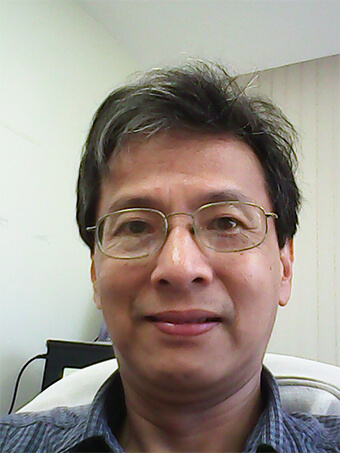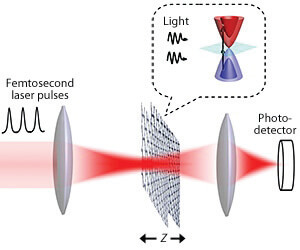
Email: phyjiwei@nus.edu.sg
Office: S13-02-08
Tel: +65 6516 6373
Current Research
Professor Ji Wei’s research interests cover nonlinear optical phenomena in materials. Experimentally, he characterises them by with Z-scan, nonlinear transmission and nonlinear absorption spectroscopy with short laser pulses. With these experimental evidences, he establishes theoretical models to gain insights and for future designs in applications.
In particular, he focused on nano-scale materials, such as carbon nanotubes and semiconductor nanocrystals, as these materials have potential in next-generation photonic and optoelectronic applications. Recently, his research interests have been extended to 2D materials and metal-organic frameworks (MOFs), which show promising for micro-scale, solid-state polariton lasers and exciton-polaritonic quantum devices.
He has co-authored over 270 research papers, and his h-index is above 69 by Google Scholar, as of July 2023.
 Two-photon absorption in bilayer graphene.
Two-photon absorption in bilayer graphene.
Exciton-Polaritonics with Advanced Materials 
Lasers and optical nonlinearities are highly desired for many technologies, such as information technology, medical imaging technology, and laser radar technology, named as a few examples. In these technologies, compact, fast, and efficient optical materials for lasers or nonlinear optical devices find an essential role. However, conventional semiconductor lasers require the pumping power for the lasing threshold has reached a bottleneck: a fundamental lower bound governed by the carrier density required to reach population inversion, or the transparency condition. This limitation can be overcome in a new type of laser, a polariton laser, which operates under a different mechanism, as called exciton-polaritonics. In this mechanism, an exciton in a material interacts with a photon mode in an microcavity, resulting in much lower lasing thresholds and/or greater optical nonlinearities. These prospects have propelled intense research effort on exciton-polaritons in a variety of materials including inorganic widegap semiconductors and organic crystals.
Here, we will first focus on metal-organic frameworks (MOFs), a newly emergent material platform, for their potential applications in polariton laser technology with an extreme-low lasing threshold. MOFs are a type of materials made up of a combination of metal ions coordinated to organic linkers. The linkers bind the whole framework together to keep it stable, and the metal ions are arranged in shapes to form one-, two-, or three-dimensional structures. Often, these materials have long pores and channels running through them, similar to porous pieces of rock, and small molecules can pass through these channels and interact with specific sites.
Prof. Ji Wei and his research team have been taking advantage of the excellent chemical binding capabilities to bind a dye molecule, Rhodamine B, into the MOF structure. These MOFs render the exciton-polariton properties in a two-dimensional crystalline platform. One of the key advantages is that these MOF crystals can be synthesized by an incredibly straightforward and cost-effective method, as compared to traditional approaches, which often involve trying to coat layers of the reflective material and chemical substrate to build up the structure that is required for exciton-polariton devices. In addition, the researchers found an extremely low lasing threshold with this novel exciton-polariton laser.
Selected Publications
- D. Kottilil, …, W. Ji, “Triple Threshold Transitions and Strong Polariton Interaction in 2D Layered Metal-Organic Framework Microplates”, ADVANCED MATERIALS, 10.1002/adma.202209094, Early Access, (FEB 2023).
- F. Zhou, … , W. Ji, “Perovskites: Multiphoton Absorption and Applications”, ADVANCED OPTICAL MATERIALS 9, 2100292 (2021).
- F. Zhou, …, W. Ji, “2D Perovskites with Giant Excitonic Optical Nonlinearities for High-Performance Sub-Bandgap Photodetection”, ADVANCED MATERIALS, 31, 1904155 (2019).
- F. Zhou and W. Ji, “Two-photon absorption and subband photodetection in monolayer MoS2”, OPTICS LETTERS 42, 3113 (2017).
- F. Zhou and W. Ji, “Giant three-photon absorption in monolayer MoS2 and its application in near-infrared photodetection”, LASER & PHOTONICS REVIEWS 11, 1700021 (2017).
- H.S. Quah, W.Q. Chen, M.K. Schreyer, H. Yang, M.W. Wong, W. Ji and J.J. Vittal, “Multiphoton harvesting metal-organic frameworks”, NATURE COMMUNICATIONS 6, 7954 (2015).
- H. Yang, X. Feng, Q. Wang, H. Huang, W. Chen, A.T.S. Wee, and W. Ji, “Giant two-photon absorption in bilayer graphene”, NANO LETT 11, 2622 (2011).
- J. He, Y. Qu, H. Li, J. Mi, W. Ji, “Three-photon absorption in ZnO and ZnS crystals”, Optics Express 13 (23), 9235-9247 (2005).
- P. Chen, X. Wu, X. Sun, J. Lin, W. Ji, K.L. Tan, “Electronic structure and optical limiting behavior of carbon nanotubes”, Physical Review Letters 82 (12), 2548 (1999).
- X. Sun, R.Q. Yu, G. Q. Xu, T. S. A. Hor, W. Ji, “Broadband optical limiting with multiwalled carbon nanotubes”, Applied Physics Letters 73 (25), 3632-3634 (1998).
